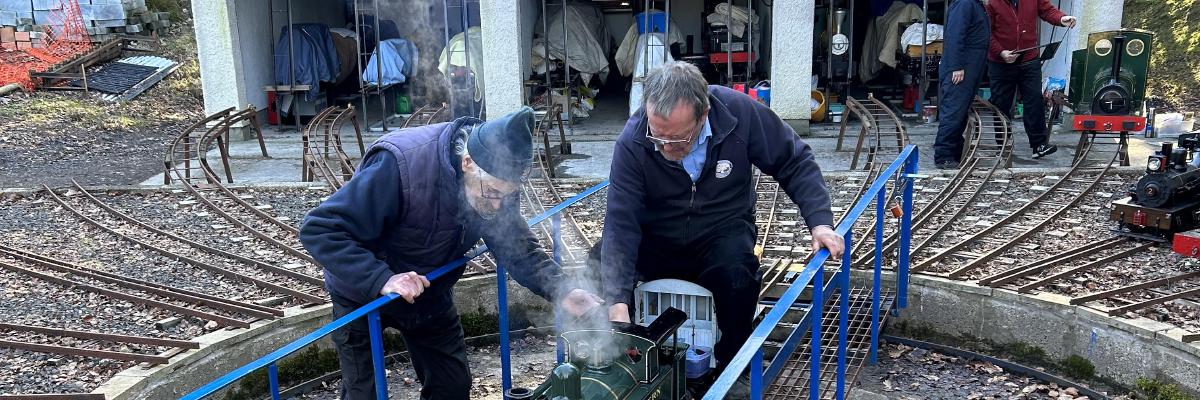Recently there was a request for articles to interest both the non-members and the membership. It strikes me that such articles might also stimulate the enthusiasm of the relative beginners to our hobby. As usual this is not a new concept and I remember LBSC targeting articles for the “tyros” as he called beginners in the 1960s. Many clubs have formal talks together with displays of work in progress which seem to be very successful. At least in part this can now, of course, be shared digitally. As a new member of the society I also think this is a great way for me (and other new colleagues) to get to know the other members. It is also a good way to obtain help as it is obvious there is a wealth of talent within the membership.
The early years
It may seem a bit strange for a nearly retired doctor to be interested in engineering but there seems to be quite a few of us. I might argue that its genetic as my grandparents were civil engineers but whatever I have been taking things to pieces since very small and as I got older managing to put an increasing number back together again. I was never much interested in model railways but liked Victorian engineering and as much of this relied on steam was drawn towards working steam engines. My father found an old unnamed lathe and we got it going to the extent my bored holes were within a quarter of an inch round! Despite the limitations of this machine I loved it and with no real help learnt some of the basics of turning together with hand fitting with files. Sometimes chisels, large hammers and expletives (not in front of my patients) also seem to help. I don’t think I managed to make anything useful…
Then Epiphany. I found a copy of the Model Engineer in WH Smiths on the shelf just below the adult magazines. I cannot think for a moment how I found that shelf as a teenage boy. Anyway I bought it and took it home to read (the ME that is). I was probably quieter for a couple of hours than I had ever been digesting the articles and the new series from Martin Evans 1.0 describing the construction of Torquay Manor. This was in 1974, I think. My parents readily agreed to getting this every fortnight – probably as it gave them peace and quiet for a few hours. However then I found Teesside Model Engineering Society which was fairly close by and joined as a junior member. This was really fantastic as I soon was allowed to drive the club locomotive (a “CHUB” I seem to remember), draw on the experience of the older and more experienced members and use the club machines (with instruction). I soon was able to bore a hole within an eighth of an inch which was an improvement. The real issue being that the Myford ML7 was worn out and the Little John (5” variable speed lathe) didn’t work.
Despite these limitations I was well and truly hooked on Model Engineering - particularly locomotives. I then made a mistake career-wise and at the last minute changed from Mechanical Engineering to Medicine a week before I was due to start at Uni. As I was lucky enough to have the A level results required I just had to sit the next year out. I decided that I would get a really useful job over this period which would help me in my chosen career so I ended up working in a scrapyard! Of course I had not taken into account the dire employment situation over this period which was probably mirrored all over the industrial parts of the country. I was lucky to get this job and never regretted it. However it made me grow up quickly. I got it as my predecessor had virtually lost both his legs as he jumped down into a loading bay to save a brush from being crushed by a heavy skip which was being swung up onto the lorry when the chains snapped… A start time of 0700 was shock to the system as was Croda next door (smelly+++) and an introduction to a totally inept boss. I could write a book about him but he was the overall bosses son, approximately my age and shall we say lacked a degree of neurological connections. He wrecked at least 5 gearboxes in his 18 year old present of a Range Rover but the most memorable exploit was to tell us off for not oxy-acetylene burning off the bolts of a large oil filled transformer. He decided to show us as we ran for cover. How he was not killed was a miracle. We were all deaf for a week following the resultant explosion.
Anyway the silver lining was that the job was well paid and I managed to save up (or project earnings) for a new Super 7 Myford sans most accessories as I could not afford them. I also bought a Chinese drill (which was truly awful) and a Grinder. After my order went in 6 months passed then Kays (a dream emporium of all things tools now of course consigned to history) phoned up to say my lathe had arrived and when did I want it delivered. The slot an hour after the phone call was surprisingly unavailable but it duly arrived in its wooden packing crate and with a considerable struggle was installed in a converted coal shed. After the usual cleaning off of liberally applied Ensis oil, oiling up with different oil, getting covered in the different oil and leveling thoughts then turned to what was I going to make.
What to make?
Like many before me I had already started to make a “Tich” since joining the TSMES and had progressed to an extent. The frames, stretcher, cylinder blocks, wheels etc had all been made and a critical inspection revealed not to be too bad workmanship but, in my self-critical assessment, it was in reality too small for anything other than an ornament. Admittedly if I lost 4 stones in weight, had a gale blowing behind me and had a continuous downhill gradient I might have made it round the elevated track but…
So I therefore looked at the bewildering choice of locomotive designs and available castings. I set some rules such as 5” gauge, relatively simple construction, outside cylinders, simple (ish) valve gear, reasonable size and easy to construct boiler. These parameters were then applied to the offerings from Reeves, Blackgates, Kennions, Don Young etc and resulted in 0 hits. In fairness this was before some designs such as Don’s Railmotor and RJ Bray’s designs were published. Its funny however how things turn out as virtually the next month the new Engineering in Miniature magazine started to serialize Jack Buckler’s Sweet Pea design with castings available from Blackgates. I poured over the article and drawings for ages before deciding that this was the engine for me, for me although I was not tempted to also write a sea-shanty.
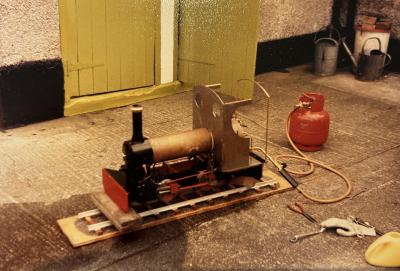
Now one has to temper this decision with the fact that I was 18 or nearly 18, due to start Uni in a year and not having very much free money although with reasonably good workshop tools. I still think I made the right choice for me and would without hesitation recommend a Sweet Pea or one of its other siblings. There is now a large choice of options, ready made parts and considerable help available from Blackgates to the constructor. I found it straightforward to build (even with only a vertical slide as a substitute milling machine). It was also relatively quick to build (15 months in my case) and worked “out of the box” or more accurately “out of the stool in the workshop on which it had been balanced”. With respect to other designs I would encourage others to build a not too complicated engine of their choice as it will realistically take years but you will enjoy every step of the way if its really something you want to make. Personally I think there has been a recent obsession on super-detailed models when simpler engines from the stables of Martin Evans 1.0 and LBSC are still excellent projects despite occasional annoying drawing errors. Sometimes there are a few engines which one finds attractive and the more one thinks about it the harder it gets to decide which to model. Perhaps a strategy of sticking a pin in a list or a personal tombola might help but do not use this to decide on your future partner or at least admit to it. You have been warned! If you can afford it a ready made locomotive has much to commend it at least until your own is ready to leave the shed.
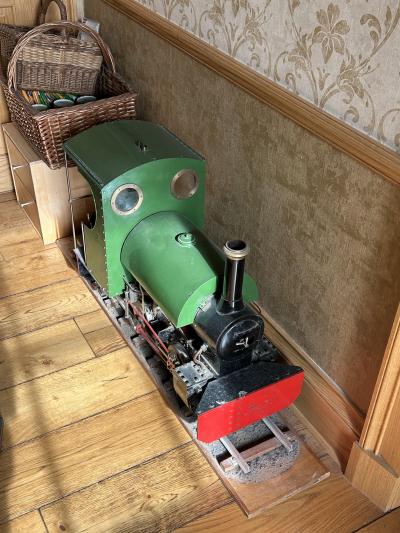
Workshop tools
Just considering machine tools there are probably more opinions on this topic than grains of sand on the local beach and personally I don’t think there is any right or wrong answers. However there are some basic principles which might help. The lathe will be your major machine tool and should be sized appropriately. I would suggest avoiding mini lathes for 3.5 gauge and above as they will be be too small. A 3.5 to 5 inch center lathe from a good manufacturer/importer will be fine for 3.5 and 5” locomotives and for 7.25 gauge I would recommend a 5 or 6” gap bed lathe. You will need a machine with back gear or electronic equivalent. The old adage is that you can do small work on a large machine but cannot do large work on a small machine… If you are buying new essentially the same machine will be marketed by different companies although it may be painted a different colour and have different badges. Suggest stick to companies with a good reputation and not the cheapest. I think it was Henry Rolls who said that the feeling of quality was maintained long after the price was forgotten. If you don’t have a milling machine then a lathe which can take a vertical slide becomes essential. A drilling machine will be required and be very picky about them. I think a bit battered old British one is much superior to many of the horrible imported ones on the market. Finally you will need a decent grinding machine of which there are many on the market but please make sure it has a good tool rest and guarding. If in doubt ask the club members for advice.
The wilderness years
Actually this is a clickbait title as I haven’t had any wilderness years. However Medicine did take over my life followed by having a family of 3 children, 1 dog, 1 horse, 2 rabbits and an ancient house to restore (which seemed a good idea at the time – it wasn’t). However I continued to potter along and rebuilt a steading to create a workshop. I also collected a variety of machine tools which I restored and now offer an illustration of how I have arrived at my current workshop.
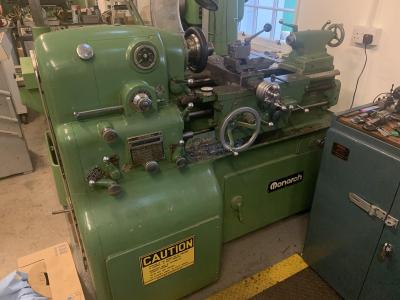
- Myford S7 no-gearbox. Very nice machine but too small for requirements
- Harrison M300. Ex school and hence had no paint left on it (little darlings). Actually a good machine and only changed due to upgrading.
- Hardinge HLV-H. Ok the great George Thomas thought this was the best small lathe ever made. I disagree and could not get on with it despite the theoretical advantages. In reality too small for me too.
- Monarch 10ee. A very rare beast in the UK and obtained from Bell Electronics in New York. It warrants a full article but suffice to say its still accurate to within 5 microns despite being made in 1969. It’s a 6.5 x 20” machine. Absolutely fabulous lathe. If you want a new one just $120,000 – bargain. The English CVA was a copy but whether its as good I don’t know.
- Dean Smith and Grace 1307 x 48 Gap Bed. Another outstanding lathe. Its in reality a 14” machine which can swing 22” in the gap. Rebuilt back to manufacturers specification. Its covered in EN19 swarf at the moment due to a big job being done. Fully equipped including the spherical turning attachment.
- Maho 800 MH milling machine. This was virtually bought by accident from a very honest machine tool dealer. When it arrived it was as expected seized as it had been dumped in the corner of a university machine shop probably with water dripping on it. It took some concentrated effort to free it up (including thumping the horizontal support with a sledge hammer whilst balanced on the top opf a step ladder – sorry HSE). Its now however my go to mill. It is staggeringly accurate and has 8 axes of movement and only lacks the power quill which many had. Despite being quite a big machine (3.5T) it can do all sizes of work.
- Aciera F3. A bit worn but well-equipped and incredibly versatile small milling machine. Great for small components. Getting increasingly familiar with it.
- Fobco 16mm Universal. Bought as new old stock and a very useful machine.
- Pollard 2MT radial. Bought by the MOD with our money and used as a glorified clothes rack for most of its life. Rescued via an auction. Very good and useful machine. Has essential working DC instant stop brake. (Drilling machines are regarded as the most dangerous machines in a workshop).
- Elliott Number 4 die filer. A real survivor from 1957. Recently restored and now functioning well (I started off with the file upside down durrr…) Has a jewellers saw attachment which needs some work.
Return back to Model Engineering…
So after a working lifetime of medicine and being a senior NHS manager (no rude comments please) I am now able to progressively return to the hobby I love. I am lucky in that my wife is supportive most of the time (except when I haven’t done something I should have thought of), my children are older and in many ways self-supportive apart from the parental taxi service and I have a well-equipped workshop. The latter has evolved over many years and despite the current virtual embarrassment of riches I still remember the grounding in building an engine with fairly basic facilities.
Current project
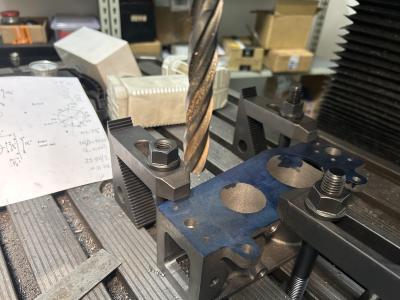
I am currently building a Stuart number 3 compound engine from I think 1903. Its quite large and sufficiently complicated to lead to quite a bit of head scratching but the casting quality is excellent. I think there are a few more months of work before its finished and I propose to show this to the membership over the next few months if there is interest. This one is not a beginners engine.
I am also finishing a driving tender for my locomotive so that cold water can be provided to the injector and an efficient brake is available. At present the brake is useless and seems to speed things up when applied. Perhaps I should try and make a perpetual motion machine before this magic wears off.
The R1
As I knew it was going to take a couple of years minimum to build my own engine I persuaded higher management that it would be a good idea to buy a ready to run engine to fill in particularly as I was not getting any younger. Perhaps as I had just done the ironing or something my wife readily agreed and as I had a narrow gauge engine I looked for a 7.25 gauge mainline type of locomotive. I therefore bought a substantial RI 0-6-0 which weighs over 120kg. It is fair to say that I did have some problems with it on delivery but this was not the fault of the marketing company but the manufacturer. It was quickly sorted and now awaits its formal boiler ticket although it has a fully certified TIG welded boiler. One important thing we did find was that the bush threads into the boiler are metric but the fittings are imperial. M10 x 1 is dangerously close to 3/8 x 26…

Future project
So anticipating the completion of the Stuart 3; I was considering many different locomotives to build. However the elegance of the rebuilt Ramsbottom LNWR 2-2-2 virtually chose itself. Chris Rayward (previously known as Hotspur Designs) had designed a 5” gauge version so I contacted him and he could not have been more helpful. He was able to supply me with drawings (now obtainable via Blackgates) and put me in touch with another model engineer who was building a 7.25 gauge version as I wished to do. I now have all the essential castings too by re-using his patterns. The next stage is laser cut frames and platework and this is also well in hand. This cooperation and help from fellow model engineers could not be a better example of the support which is readily available to anyone wishing to take up such an absorbing hobby. Although I am essentially a locomotive man it does not matter whether your interest is locomotives, traction engines, cranes, 3D printing or stationary engines. I do hope therefore that these few words will encourage anyone thinking of building a steam powered model to join us.
